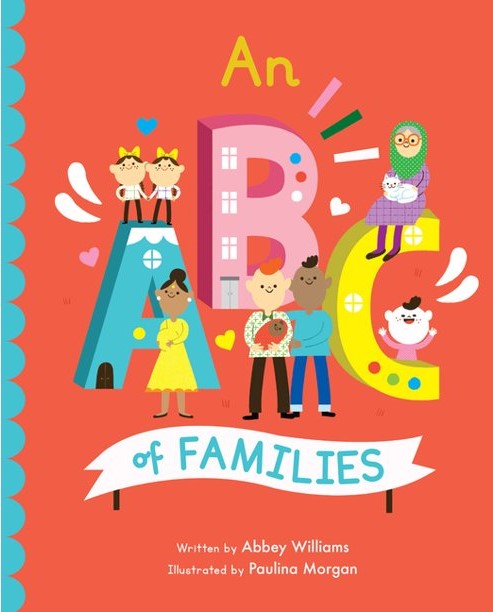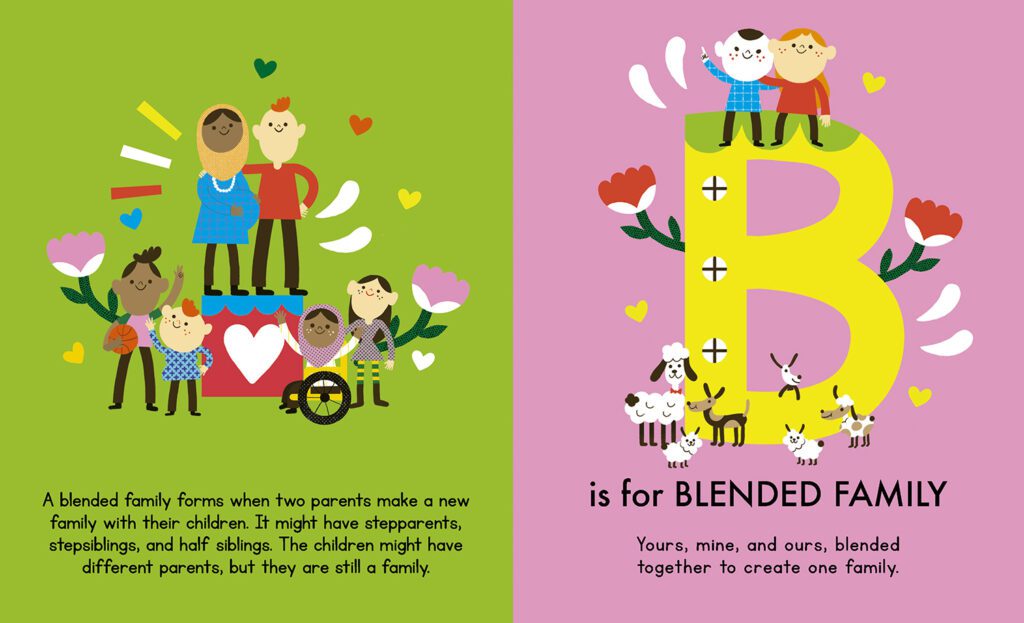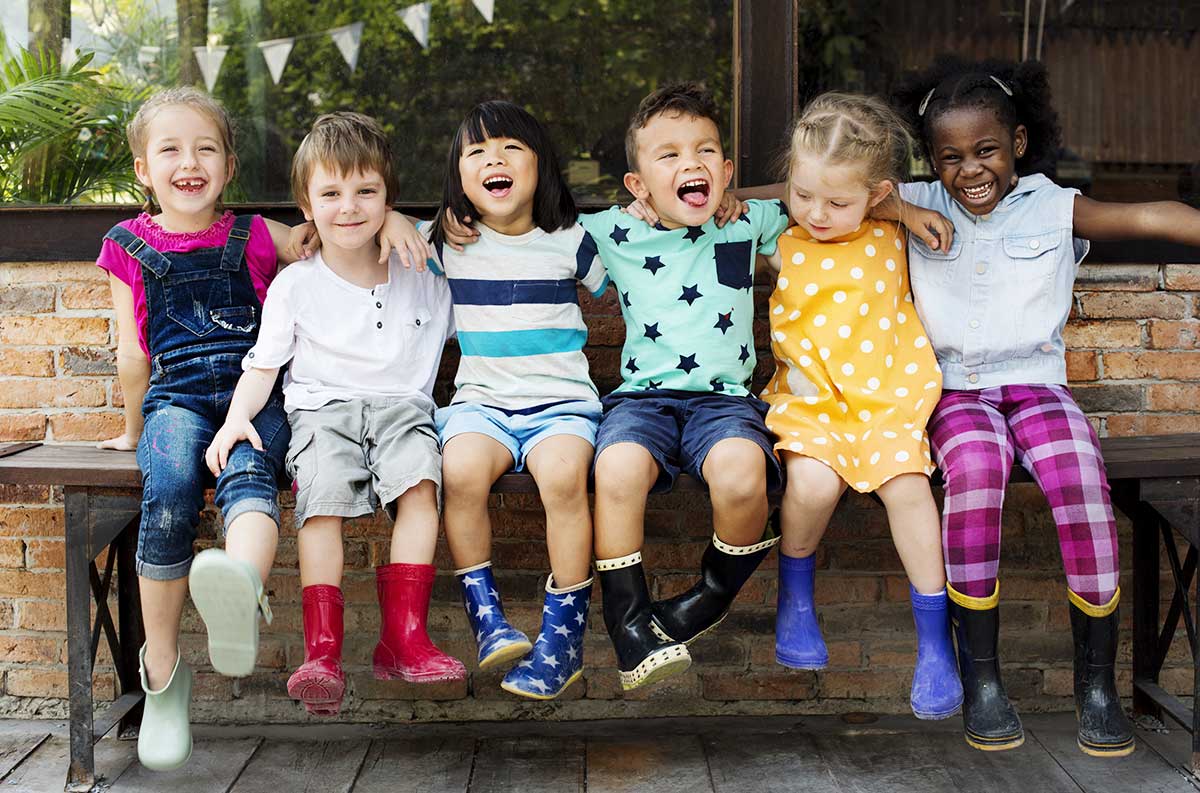
Inclusive Children's Book Teaching Guide
An ABC of Families
What is this book about?
A is for Adoption, B is for Blended Family, C is for Co-Parenting.
Whether you have two dads, an adopted brother, three stepsisters, or divorced parents, every family is the perfect family. This durable board book helps the youngest children explore complicated concepts in an accessible, fun and memorable way. Each right-hand page includes a brightly decorated letter with the word it stands for and an encouraging slogan. On the left-hand page, a colorful illustration and a short paragraph sum up the concept.
Cheerful people from a range of backgrounds, ethnicities and abilities in all different types of families lead the way through the alphabet:
- M is for Mom. The main gal(s) in the family.
- L is for Lineage. Where is your family from?
- T is for Traditions. The special things your family does together.
- U is for Unconditional Love. The most magical kind of love!
A sister title to the bestselling book, An ABC of Equality, this inclusive alphabet book shows young children how to celebrate our differences, spread kindness and understand our diverse world.
Who is depicted in this book?
- Diverse families and children, including LGBTQ+ families
What early childhood themes and concepts does this book explore?
- Families and their different forms (foster, blended, LGBTQ+ led)
- This is also an alphabet book, so capital letters and the basic vocabulary of family structures, members and related concepts such as tradition, home and joy are presented in the text.
How does this book support anti-bias education?
An ABC of Families can be used to affirm different types of families, spark conversations about prejudice (such as someone saying that only a certain type of family is acceptable or best), and lay the foundation for young children to form deep, caring connections across all dimensions of human diversity.
Depending on how the book is shared or used—and the developmental level of the children—An ABC of Families may be used to support the following core goals from the book, Anti-Bias Education for Young Children and Ourselves:
Identity—Teachers will nurture each child’s construction of knowledgeable and confident personal and social identities so that children will demonstrate self-awareness, confidence, family pride, and positive social identities.
Diversity—Teachers will promote each child’s comfortable, empathetic interaction with people from diverse backgrounds so that children will express comfort and joy with human diversity, use accurate language for human differences, and form deep, caring connections across all dimensions of human diversity.
How can this book be used to meet early childhood learning standards?
For all ages
Use An ABC of Families to meet early childhood literacy standards
For children from birth to age three
Teaching suggestion: Point out and talk about the letters, colors and familiar objects on each page of the book.
What Illinois Early Learning Guideline does this meet for children from birth to age three?
Developmental DomainLanguage Development, Communication and Literacy
Standard: Early LiteracyChildren demonstrate interest in and comprehension of printed materials.
Indicators for children:
- Points to familiar pictures and actions in books (16–24 months)
- Recites part of the book from memory (21–36 months)
What Illinois Early Learning Guideline does this meet for children from birth to age three?
Developmental DomainCognitive Development
Standard: Concept DevelopmentChildren demonstrate the ability to connect pieces of information in understanding objects, ideas and relationships.
Indicators for children:
- Begins to identify and name objects and people (16–24 months)
- Begins to identify characteristics of the object, such as “red ball” (16–24 months)
- Identifies characteristics of objects and people when named, such as colors (21–36 months)
Teaching suggestion: Point out family members and encourage children to name their family members and talk about them.
What Illinois Early Learning Guideline does this meet for children from birth to age three?
Developmental DomainSocial-Emotional Development
Standard: Self-ConceptChildren develop identity of self.
Indicators for children:
- Shows awareness of significant people by calling them by name, such as “papa” (7–18 months)
- Points to self in media (16–24 months)
- Names people in their family and shares stories about them (21–36 months)
For preschoolers (ages three to five)
Teaching suggestion: Identify letters while exploring the book.
What Illinois Early Learning and Development Standards does this meet for preschoolers?
Language Arts Standard4BDemonstrate an emerging knowledge and understanding of the alphabet.
Benchmark 4.B.ECa:
With teacher assistance, recite the alphabet.
Benchmark 4.B.ECb:
Recognize and name some upper/lowercase letters of the alphabet, especially those in own name.
Teaching suggestion: Select and share examples of varying family structures on pages focusing on A (adoption), B (blended), C (co-parenting), F (foster), and N (nuclear). Notice, narrate and introduce vocabulary for these terms.
What Illinois Early Learning and Development Standards does this meet for preschoolers?
Social Studies Standard18BDevelop an awareness of self within the context of family.
Benchmark 18.B.ECa:
Understand that each of us belongs to a family and recognize that families vary.
Teaching suggestion: Invite the children to talk about family structure. Ask: "Who is in your family? What is the same and different among families? What is something great about your family?" Incorporate families into pretend play and creative arts exploration.
What Illinois Early Learning and Development Standards does this meet for preschoolers?
Social Studies Standard18BDevelop an awareness of self within the context of family.
Benchmark 18.B.ECa:
Understand that each of us belongs to a family and recognize that families vary.
See inside this book.

